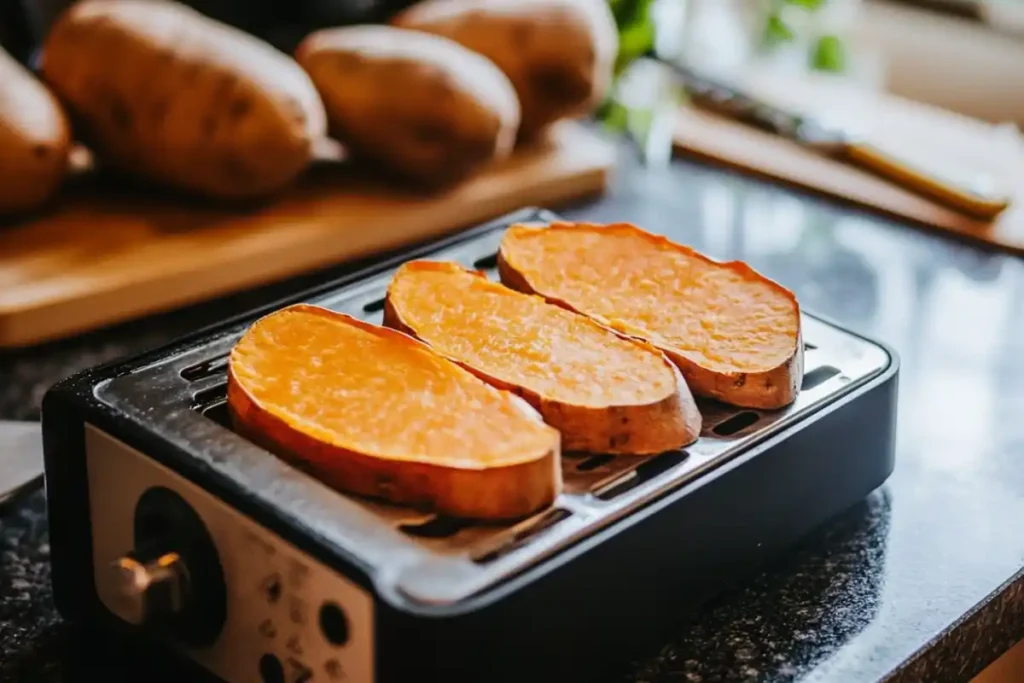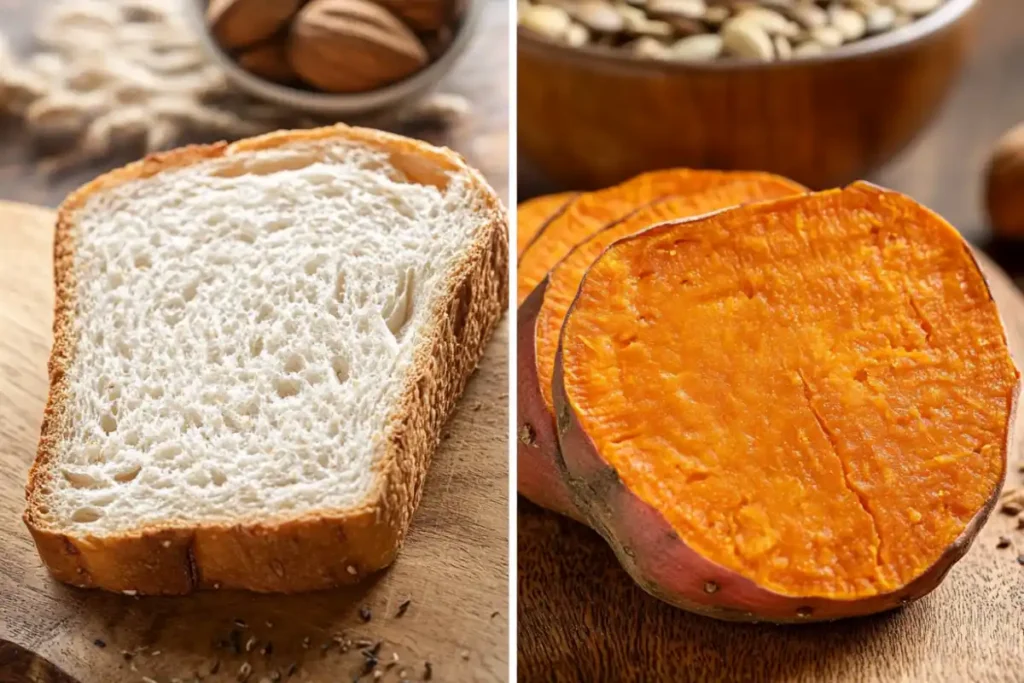Bread has been a staple in diets around the world for centuries, but with rising concerns about gluten intolerance, blood sugar spikes, and processed ingredients, many are searching for healthier alternatives. One option gaining popularity is sweet potatoes, a naturally sweet, fiber rich, and nutrient dense food. But is sweet potato a good substitute for bread in terms of taste, texture, and health benefits?
This article explores the potential of using sweet potatoes as a bread alternative. We’ll compare their nutritional value, examine how they affect blood sugar levels, and dive into creative ways to use them in meals. Plus, we’ll provide practical tips on incorporating sweet potatoes into your diet. If you’re curious whether making the switch is right for you, read on!
Understanding Sweet Potatoes as a Bread Substitute
Nutritional Profile of Sweet Potatoes vs. Traditional Bread
When it comes to nutrition, sweet potatoes and bread offer vastly different benefits. Traditional white bread is often made from refined flour, which lacks fiber and essential nutrients. On the other hand, sweet potatoes are packed with fiber, vitamins, and minerals that contribute to overall health.
- Carbohydrates & Fiber: While both contain carbs, sweet potatoes have more fiber, which helps with digestion and slows down sugar absorption.
- Protein & Fats: Bread contains more protein, but sweet potatoes offer healthier carbs with a lower glycemic impact.
- Vitamins & Minerals: Sweet potatoes are rich in vitamin A, potassium, and antioxidants, whereas most bread lacks significant micronutrients unless fortified.
Health Benefits of Sweet Potatoes
Swapping bread for sweet potatoes comes with some impressive health perks:
- Better Blood Sugar Control: Unlike white bread, which causes quick sugar spikes, sweet potatoes have a lower glycemic index, leading to a steadier release of energy.
- Improved Digestive Health: Thanks to their high fiber content, sweet potatoes support gut health by promoting healthy digestion.
- Rich in Antioxidants: The beta-carotene in sweet potatoes converts to vitamin A, supporting immune function and eye health.
Gluten-Free Advantages
For those with celiac disease or gluten intolerance, finding suitable bread alternatives is crucial. Sweet potatoes are naturally gluten-free, making them a great option for those avoiding wheat. Plus, they fit well into paleo, Whole30, and low-carb diets.
Culinary Applications of Sweet Potatoes as Bread Alternatives
Exploring the versatility of sweet potatoes reveals numerous delicious ways to incorporate them into your meals as bread substitutes. From toasts to buns, these alternatives not only satisfy your cravings but also offer enhanced nutritional benefits.
Sweet Potato Toast: A Versatile Bread Replacement
Sweet potato toast has emerged as a popular and nutritious alternative to traditional bread. Here’s how you can prepare and enjoy it:
- Preparation Methods: Start by selecting medium sized sweet potatoes with even surfaces. After washing and drying, slice them lengthwise into 1/4-inch thick pieces. You can then:
- Toasting: Place the slices directly into a toaster on the highest setting, repeating the process until they’re tender and slightly crispy.
- Baking: Arrange the slices on a baking sheet, lightly brush with olive oil, and bake at 400°F (200°C) for about 20 minutes, flipping halfway through.
- Topping Ideas:
- Savory Options: Avocado with a sprinkle of chili flakes, hummus and sliced cherry tomatoes, or a poached egg with spinach.
- Sweet Options: Almond butter with banana slices, Greek yogurt drizzled with honey, or a spread of ricotta cheese topped with berries.
This method not only answers the question, is sweet potato a good substitute for bread, but also showcases its adaptability in various flavor profiles.

Sweet Potato Based Breads
Incorporating sweet potatoes into bread recipes can yield moist, flavorful loaves that serve as excellent alternatives to conventional bread.
- Incorporating Sweet Potato Puree: By adding mashed sweet potatoes to your bread dough, you introduce natural sweetness and moisture. This technique is particularly effective in quick breads and yeast-based loaves.
- Benefits: The addition of sweet potato results in a tender crumb and rich flavor, reducing the need for excessive sugars or fats. Moreover, it boosts the nutritional profile with added vitamins and fiber.
For a delightful recipe, consider trying this Sweet Potato Bread that combines mashed sweet potatoes with warm spices for a comforting treat.
Innovative Recipes Utilizing Sweet Potatoes
Beyond toasts and traditional loaves, sweet potatoes can be transformed into various bread-like creations:
- Sweet Potato Flatbreads and Wraps: Combining mashed sweet potatoes with flour and seasonings can create pliable flatbreads suitable for wraps or as accompaniments to dips. These flatbreads are not only soft but also imbued with the subtle sweetness of the potatoes.
- Sweet Potato Buns for Burgers and Sandwiches: For a gluten-free and nutrient-rich option, consider using roasted sweet potato rounds as buns. Simply slice the sweet potato into thick rounds, roast until tender, and use them to sandwich your favorite fillings.
These innovative applications not only diversify your meals but also provide healthier alternatives to traditional bread products.
Health Implications of Replacing Bread with Sweet Potatoes
Substituting bread with sweet potatoes can have notable effects on health, particularly concerning blood sugar regulation, weight management, and digestive health.
Impact on Blood Sugar Regulation
The glycemic index (GI) measures how quickly foods raise blood sugar levels. Foods with a high GI can cause rapid spikes, while those with a low GI result in a slower increase.
- Glycemic Index Comparison: Sweet potatoes generally have a lower GI compared to white bread. However, the cooking method significantly influences their GI:
- Boiled sweet potatoes have a lower GI, making them preferable for blood sugar control.
- Baked or roasted sweet potatoes tend to have a higher GI due to the breakdown of resistant starches during cooking.
Understanding these variations is crucial for individuals managing blood sugar levels, such as those with diabetes.

Weight Management Considerations
Incorporating sweet potatoes in place of bread can aid in weight management:
- Satiety Levels: The high fiber content in sweet potatoes promotes a feeling of fullness, potentially reducing overall calorie intake.
- Caloric Density: While both sweet potatoes and bread provide carbohydrates, sweet potatoes offer additional nutrients and fiber, making them a more nutrient-dense choice.
These factors contribute to better appetite control and can support weight loss or maintenance efforts.
Digestive Health Benefits
Replacing bread with sweet potatoes can positively impact digestive health:
- Fiber Content: Sweet potatoes are rich in dietary fiber, which aids in regular bowel movements and prevents constipation.
- Prebiotic Properties: Certain fibers in sweet potatoes serve as food for beneficial gut bacteria, promoting a healthy microbiome.
These digestive benefits further underscore the advantages of choosing sweet potatoes over traditional bread.
In conclusion, the question is sweet potato a good substitute for bread encompasses various factors, from culinary versatility to health implications. By understanding and implementing these alternatives, you can enjoy diverse, nutritious, and satisfying meals.
Practical Tips for Incorporating Sweet Potatoes into Your Diet
Integrating sweet potatoes into your meals as a bread substitute can be both simple and rewarding. Here are some practical tips to help you get started:
Selection and Storage
- Choosing the Right Variety: Opt for firm, medium sized sweet potatoes with smooth skin, free from blemishes or sprouts. Varieties like Beauregard or Garnet are ideal for toasting due to their natural sweetness and moist texture.
- Proper Storage Methods: Store sweet potatoes in a cool, dry, and well ventilated area, away from direct sunlight. Avoid refrigerating them, as this can alter their taste and texture.
Preparation Techniques
- Efficient Peeling and Slicing: While the skin is edible and nutritious, peeling is optional based on personal preference. For toasts, slice the sweet potato lengthwise into 1/4-inch thick pieces using a sharp knife or mandoline for uniformity.
- Cooking Methods: To make sweet potato toast, you can use a toaster or oven:
- Toaster Method: Place the slices directly into the toaster on the highest setting. It may require 2-3 cycles to achieve the desired tenderness.
- Oven Method: Preheat the oven to 400°F (200°C). Arrange the slices on a baking sheet lined with parchment paper and bake for 20-25 minutes, flipping halfway through.
- Meal Prepping: Prepare a batch of sweet potato slices in advance and store them in an airtight container in the refrigerator for up to 5 days. Reheat in a toaster or oven as needed.
By following these tips, you can seamlessly incorporate sweet potatoes into your diet, offering a nutritious and delicious alternative to traditional bread.
Frequently Asked Questions (FAQs)
1. Can sweet potatoes replace bread in all recipes?
While sweet potatoes are versatile, they may not be suitable for all recipes that traditionally use bread. They work excellently as toasts, buns, or in flatbreads but might not replicate the texture needed for dishes like sandwiches requiring sturdy slices.
2. Are there any downsides to using sweet potatoes instead of bread?
One consideration is the difference in texture and flavor; sweet potatoes are naturally sweeter and softer. Additionally, individuals monitoring their carbohydrate intake should note that sweet potatoes, like bread, contain carbohydrates.
3. How do sweet potatoes compare to other bread alternatives?
Compared to options like lettuce wraps or cauliflower bread, sweet potatoes offer a unique blend of fiber, vitamins, and natural sweetness. They provide more nutrients than lettuce and are simpler to prepare than cauliflower-based breads.
4. What are some quick recipes to try sweet potato toast?
Here are a few simple ideas:
- Avocado Smash: Top toasted sweet potato slices with mashed avocado, a sprinkle of salt, and red pepper flakes.
- Nut Butter & Banana: Spread almond or peanut butter on the toast and add banana slices and a drizzle of honey.
- Egg & Spinach: Place sautéed spinach and a poached or fried egg on the toasted slice for a hearty option.
For more delicious recipes, check out our recipe article.
By exploring these FAQs, you can better understand how to incorporate sweet potatoes into your diet as a satisfying bread substitute.
Conclusion
So, is sweet potato a good substitute for bread? The answer depends on your dietary goals and personal preferences. Sweet potatoes offer a nutrient rich, fiber packed, and naturally gluten-free alternative to traditional bread. They provide steady energy, support digestive health, and promote better blood sugar control, making them an excellent option for many people.
Beyond health benefits, sweet potatoes are versatile and delicious. Whether used as toast, flatbreads, or burger buns, they bring a naturally sweet, satisfying texture to meals. While they may not replace bread in every recipe, they serve as a creative and wholesome substitute in many dishes.
If you’re looking to make healthier choices, incorporating sweet potatoes into your diet can be a simple and rewarding change. Try experimenting with different preparations and toppings to find what works best for you. After all, eating well should be both nutritious and enjoyable! 😊
